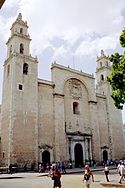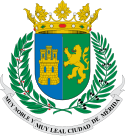Mérida (Meksyk)
 Mérida | |||||
| |||||
| Państwo | |||||
|---|---|---|---|---|---|
| Stan | |||||
| Data założenia | 6 stycznia 1542 | ||||
| Zarządzający | Mauricio Vila Dosal (PAN) | ||||
| Wysokość | 10 m n.p.m. | ||||
| Populacja (2010) • liczba ludności |
| ||||
| Nr kierunkowy | 999 | ||||
| Kod pocztowy | 97000–97299 | ||||
| Strona internetowa | |||||
Mérida – miasto w Meksyku, w północnej części półwyspu Jukatan, stolica stanu Jukatan. Liczba ludności gminy Mérida w 2010 roku liczyła ponad 830 tys. mieszkańców[1]. Miasto zostało założone na gruntach miasta Majów T'Hó po zdobyciu go przez hiszpańskiego konkwistadora Francisco de Montejo „el Mozo”. Siedziba rzymskokatolickiej archidiecezji.
Większość ulic w mieście jest numerowana[2].
Od 1987 r. w Meridzie odbywa się memoriał Carlosa Torre Repetto, poświęcony pamięci meksykańskiego szachisty.
Gospodarka
W mieście rozwinął się przemysł spożywczy, włókienniczy, skórzany, drzewny oraz cementowy[3].
Atrakcje turystyczne
- Dom Montejo – pałac konkwistadora, wybudowany w 1552 w stylu francuskim.
- Katedra św. Ildefonsa – renesansowa, najstarsza w Meksyku. Budowa rozpoczęła się w 1561 i była kontynuowana przez 36 lat przez kilkuset Majów.
- Pustelnia św. Izabeli – część jezuickiego klasztoru z 1748, odrestaurowanego w 1966 r.
- Kościół Trzeciego Zakonu Regularnego – wybudowany w 1618 jako pierwszy jezuicki kościół na Jukatanie. Do budowy użyto wapienia z majskiej świątyni.
- Ratusz – XVII-wieczny, zbudowany od nowa w 1735[2].
Miasta partnerskie
 Erie, Stany Zjednoczone
Erie, Stany Zjednoczone Nowy Orlean, Stany Zjednoczone
Nowy Orlean, Stany Zjednoczone Albacete, Hiszpania
Albacete, Hiszpania Ankona, Włochy
Ankona, Włochy Bridgeport, Stany Zjednoczone
Bridgeport, Stany Zjednoczone Cebu City, Filipiny
Cebu City, Filipiny Kopenhaga, Dania
Kopenhaga, Dania Fullerton, Stany Zjednoczone
Fullerton, Stany Zjednoczone Glasgow, Wielka Brytania
Glasgow, Wielka Brytania Villa de Guadalupe, Meksyk
Villa de Guadalupe, Meksyk Kansas City, Stany Zjednoczone
Kansas City, Stany Zjednoczone Kingston, Jamajka
Kingston, Jamajka Maracaibo, Wenezuela
Maracaibo, Wenezuela Mérida, Hiszpania
Mérida, Hiszpania Mérida, Wenezuela
Mérida, Wenezuela Miami, Stany Zjednoczone
Miami, Stany Zjednoczone Palermo, Włochy
Palermo, Włochy Panama City, Stany Zjednoczone
Panama City, Stany Zjednoczone Parma, Włochy
Parma, Włochy Santander, Hiszpania
Santander, Hiszpania Stargard, Polska
Stargard, Polska Tampa, Stany Zjednoczone
Tampa, Stany Zjednoczone Tel Awiw-Jafa, Izrael
Tel Awiw-Jafa, Izrael Valladolid, Hiszpania
Valladolid, Hiszpania Victoria, Kanada
Victoria, Kanada Yakima, Stany Zjednoczone
Yakima, Stany Zjednoczone La Paz, Boliwia
La Paz, Boliwia Cancún, Meksyk
Cancún, Meksyk
Przypisy
- ↑ a b c Perspectiva estadistica, Yucatan 2011 (hiszp.). Instituto nacional de estadística y geografía. [dostęp 2014-06-10].
- ↑ a b Stephen Wolf (pod red.): Cancún, Cozumel, Yucatán Peninsula. Fodor's, 1999, s. 140-142, seria: Fodor's 2000. ISBN 10516336.
- ↑ Mérida, [w:] Encyklopedia PWN [online] [dostęp 2021-07-25].
Zobacz też
Media użyte na tej stronie
The flag of Navassa Island is simply the United States flag. It does not have a "local" flag or "unofficial" flag; it is an uninhabited island. The version with a profile view was based on Flags of the World and as a fictional design has no status warranting a place on any Wiki. It was made up by a random person with no connection to the island, it has never flown on the island, and it has never received any sort of recognition or validation by any authority. The person quoted on that page has no authority to bestow a flag, "unofficial" or otherwise, on the island.
Autor: Pedro A. Gracia Fajardo, escudo de Manual de Imagen Institucional de la Administración General del Estado, Licencja: CC0
Flaga Hiszpanii
Flag of Jamaica. “The sunshine, the land is green, and the people are strong and bold” is the symbolism of the colours of the flag. GOLD represents the natural wealth and beauty of sunlight; GREEN represents hope and agricultural resources; BLACK represents the strength and creativity of the people. The original symbolism, however, was "Hardships there are, but the land is green, and the sun shineth", where BLACK represented the hardships being faced.
Flag of Israel. Shows a Magen David (“Shield of David”) between two stripes. The Shield of David is a traditional Jewish symbol. The stripes symbolize a Jewish prayer shawl (tallit).
Autor: the above mentioned, Licencja: CC BY-SA 4.0
Collage of the city of Mérida.
Location Map of Yucatan EPSG:3857 projection, Geographic limits of the map:
- N: 21.80° N
- S: 19.30° N
- W: 90.60° W
- E: 87.20° W
Escudo de Armas de la Ciudad de Mérida, Yucatán, México.
Escudo partido en pal, esto es verticalmente de arriba a abajo, en dos cuarteles iguales. El primero (izquierda) en campo azur (azul) ostenta un castillo de oro, y el segundo (derecha) un león rampante de oro en campo de sinople (verde). El escudo va timbrado, es decir rematado en su cúspide, con corona real, abierta. La forma o contorno del escudo corresponde al estilo heráldico español: cuadrilongo con su base redondeada. [1]
Bandera municipal de Mérida Flags of the World, Mérida Ayuntamiento de Mérida























